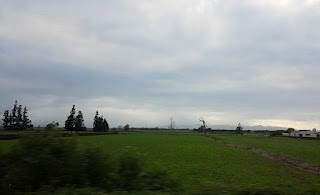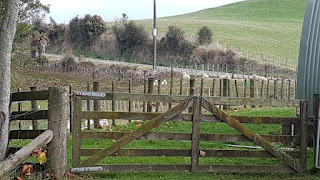There were 9 folks including us on the day trip to Rotorua. The weather and skies were very interesting on this day.
Fascinated by the clouds!
At this point the clouds/mist appeared to be rolling down from the tops of the mountains. This was very difficult to photograph from a moving van.
Proof that there are sheep in New Zealand.
Sheep tend to be found on steeper areas.
Our first stop was at Hobbiton (the shire they built in NZ for the Lord of the Rings movies.) It was built in the middle of an enormous sheep ranch so no one would know it was there and they established a no fly zone over it to keep everything hush hush. Of course the local residents were aware. And in a nice gesture, the movie's director Jackson built a hobbit building in town that I believe houses the visitor center. Many of our group left the group to do a tour of Hobbiton. Another pair left the group here and were transferred to another van to do something else.
We were able to grab a little snack here. We were pretty hungry by then!
Our next stop was at the Maori Cultural Center, Te Puia in the Whakarewewa Valley. The Valley is part o the Rotorua geothermal system and lies on the south edge of Rotorua Cauldera. It formed from a large volcanic eruption 240,000 yrs ago. Magma at great depths heats cool ground water. The hot water rises to the surface and creates geysers, mud pools, steam and gas vents and hot pools. There are roughly 500 pools and 65 geyser vents in the Valley. Water in deeper parts of the geothermal system is under great pressure and temps can reach 572F. Cooking pools used by the Maori contain boiling water which has moved to the surface. Cooking is done in baskets made of flax. It takes about 100 years for rain water to eventually emerge as hot spring water.
Kia Ora as it was explained to us means hello but also has quite a few other meanings.
Carvings such as this were placed at the entrances to fortified Maori villages. The carvings were usually of tribal ancestors or gods. This is the Gateway Whatitoka Waharoa.
We had a short tour that included a little bit about Maori culture, some cool geysers, a boiling mud pool. We also attended a Maori "concert."This is the real Maori name for this place. It is incredibly difficult to say so the guide told us about the several modifications to get it down to 2 small syllables.
Here is a map showing the 6 geysers at this site. We had a difficult time figuring out which was which.
The different geysers erupt at different times even within an hour. Pohutu is the largest geyser in the southern hemisphere. It erupts once or twice each hour and can reach 30 meters.
Our guide indicated that there is a show for a while and then no eruptions for a bit then it re-starts.
We've been around worse fumes (ex. in Hawaii) but you could smell the sulfur compounds here too. You could see the sulphur deposited on the ground.
Recognize anyone in the photo below (Hey, it is US!)
Koko Mud Pool
This is one of the largest mud pools at Te Puia. It is 6-10 meters deep. Steam and gas released rises and condenses as water just under the ground and produces an acidic liquid. The acidic liquid breaks down the rock and forms a clay that mixes with surface water to produce a steam-heated mud pool. The bubbling mud can reach 203F. In rainy conditions the mud is more fluid. If it is a drier season, the mud is more sticky. The Maori used the thermal mud to treat cuts and burns plus arthritis, rheumatism and to cleanse the skin.




































No comments:
Post a Comment
Feel free to comment or ask questions...